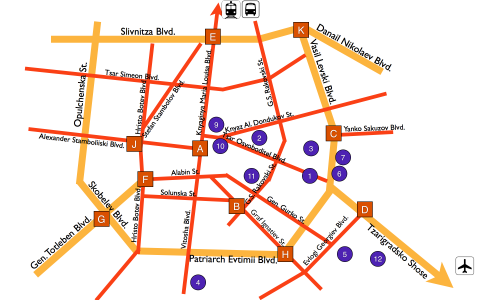Sofia’s Street Names and Major Landmarks
16.06.2012 § 2 Comments
What’s in a name? This post will give you a general idea of the layers of history and city planning in Bulgaria’s capital, based on the names of its major streets and arteries. Furthermore, it will acquaint you with several landmarks and important city squares.
Boulevards (Orange)
- Danail Nikolaev – The “father” of the Bulgarian military, minister of war on the eve of the Balkan wars
- Opulchenska – named after the Opulchenie, the Bulgarian volunteer corps in the Russo-Turkish war (of 1877-78), the first modern Bulgarian army
- Patriarh Evtimii – leader of the Bulgarian church who led the defence of Veliko Tarnovo against the Ottomans in 1393
- Skobelev – the Russian general who co-liberated Pleven during the Russo-Turkish war
- Slivnitza – the location of the crucial battle in the Serbo-Bulgarian war of 1885 which solidified Bulgarian Unification
- Gen. Totleben – the Russian general who co-liberated Pleven during the Russo-Turkish war
- Tzarigradsko Shose – literally “The road to Tzarigrad (Istanbul)”, a major artery leading towards the airport and the South-East
- Vasil Levski – named after the “apostle of freedom”, Vasil Levski, responsible for the Bulgarian liberation movement in the 1870’s
Major Streets (Red)
- Alabin St. – named after Pyotr Alabin, Sofia’s first post-Liberation mayor
- Alexander Stamboliiski Blvd. – prime minister of Bulgaria from 1919 to 1923 and leader of the Agrarian Union party
- Evlogi Georgiev Blvd. – one of the two wealthy brothers whose donation led to the creation of Sofia University in 1888
- G.S. Rakovski St. – Bulgarian revolutionary and writer, led the precursor to the liberation movement in the 1870’s
- Gen. Gurko St. – liberator of Sofia, Plovdiv and Adrianople in the Russo-Turkish war
- Graf Ignatiev St. – signed the Treaty of San Stefano at the end of the Russo-Turkish war for the Russian side
- Hristo Botev Blvd. – named after the poet and revolutionary who died on June 2, 1876 during the April uprising
- Knyaz Al. Dondukov St. – head of the Russian administration in newly liberated Bulgaria, Dondukov helped write the Tarnovo constitution
- Solunska St. – named after Solun (Thessaloniki), the co-capital of Greece and once the capital of the region of Macedonia
- Stefan Stambolov Blvd. – prime minister from 1887 to 1894, one of the founders of modern Bulgaria
- Tsar Osvoboditel Blvd. – named after Alexander II, “Tzar-Liberator”, who freed the Russian serfs and led the Russo-Turkish war
- Tsar Simeon Blvd. – named after Simeon I, tzar of the First Bulgarian Empire during its Golden Age
- Vitosha Blvd. – named after the mountain towering above Sofia
- Yanko Sakuzov Blvd. – a co-founder of the Bulgarian Social Democratic Worker’s Party in 1894
Squares (Brown)
- A: St. Nedelya church
- B: Slaveykov Sq. – named after Petko R. Slaveykov, a Revival-era poet and writer, Slaveikov square is Sofia’s largest outdoor book market
- C: Vasil Levski monument – the site of the hanging of national hero Vasil Levski
- D: Orlov Most – “The Eagles’ Bridge”
- E: Luvov Most – “The Lions’ Bridge”
- F: Macedonia Sq. – Macedonia square, named after the region of Macedonia
- G: Russian Monument Sq. – named after the Russian monument built in 1882 to commemorate the liberating Russian army
- H: Patriarh Evtimii Sq. – also known as “Popa” (“The Priest”), this square is a major transit hub and a favourite meeting place for Sofia residents
- J: Vuzrajdane Sq. – its name means “Rebirth” or “Revival”, referring to the period preceding Bulgarian liberation
- K: Stochna Gara – “Cargo Train Station”
Landmarks (Purple)
1. Parliament
2. Royal Palace, currently the National Art Gallery and the Ethnographic Museum

3. Temple-Monument Alexander Nevski, the largest church in Bulgaria

4. National Palace of Culture, an enormous congress centre with 13 concert halls, the largest of which holds 3380 people
5. National Stadium “Vasil Levski” – the flagship soccer stadium of Bulgaria

6. Sofia University – the oldest university in the country, founded in 1888

7. National Library – the largest library in the country, founded in 1878

8. Central Department Store – currently an upscale shopping centre
9. Presidency of Bulgaria

10. National Theatre “Ivan Vazov”

11. Borisova Gradina – “Boris’s Garden”, named after its patron, Boris III of Bulgaria, is Sofia’s largest park





[…] you’re curious about Sofia, read about my ritual returns, the Essential Walk, Sofia’s street names, its use as a film shooting location, and its book markets. Share […]
[…] generous donations of two Sofia-area brothers – Evlogi and Hristo Georgievi. There’s a boulevard named after the former and their statues flank the entrance to the […]